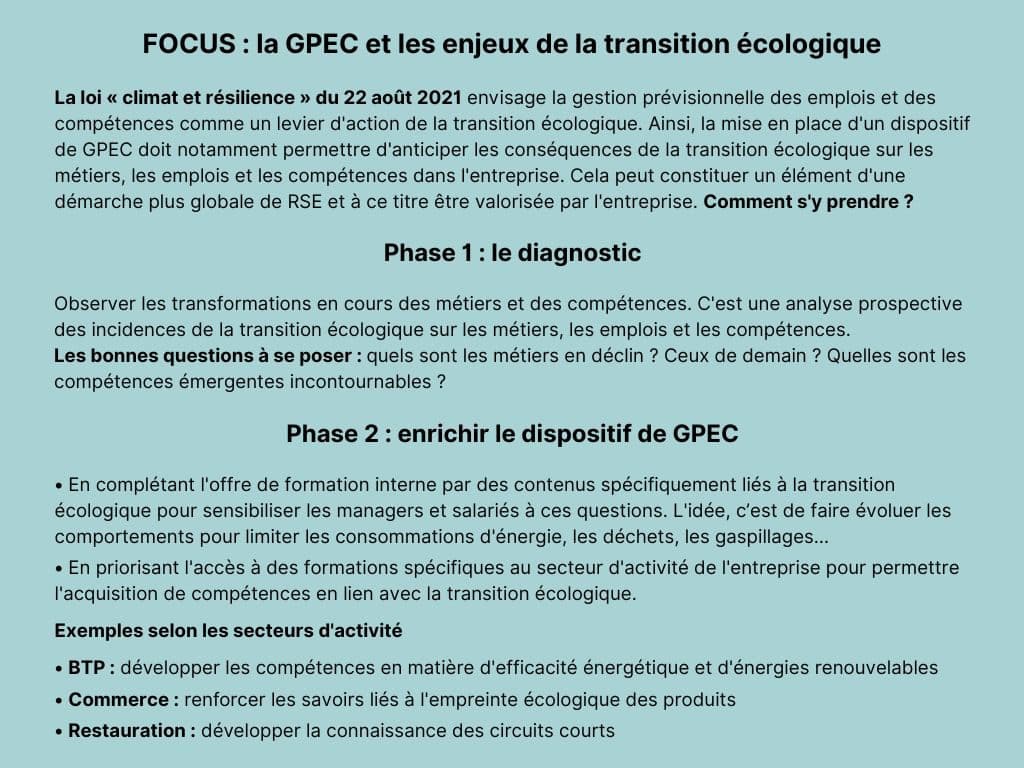Whatever the situation, the development of employee skills is of vital importance to all organisations. And even more so in a context of reorganisation and economic, technological and environmental change! A well-defined and well-targeted training policy will enable the company to improve its performance. But also to keep employees motivated! The challenge lies in accurately assessing skills needs, so that employees can be directed towards the training courses that will be most beneficial to them.

There's no longer any question of ordering X number of days of training in English or office automation for an entire department. At least, not without a precise assessment of the skills development needs within the company. Today, training must be precisely tailored to the needs of organisations and individual employees. This requires a methodical approach.
Training, a performance issue for the company
For HR and training managers, this meanscorrectly assess needs to meet the company's strategic ambitions.
Good to know:
- mastery of new tools/materials
- new management method
- quality issue
- international development
- passing on know-how to new generations
- adoption of Agile methods
- development of soft skills...
This training policy also enables the company to meet its legal obligations. The French Labour Code stipulates that employers must ensure that employees adapt to their jobs. They must also ensure that employees maintain their ability to hold a job, particularly in the light of changes in jobs, technologies and organisations. Not forgetting, of course, the compulsory statutory training courses (those for members of the CSE, For example).
It is also necessary to distinguish between collective and individual needs. It should be remembered that on an individual level, the personal training account (CPF) can be activated at the employee's initiative. The employer can top it up.
Ensuring skills development
Building a relevant training policy means first and foremost thinking in terms of "skills". Over the years, this term has become the watchword of training and employment policies. More specifically, it involves measure the gap between current skills and those expected.
In the absence of a precise legal definition, competence is generally equated with a combination of knowledge, know-how and interpersonal skills that an employee uses to carry out a task. A training action is now defined as " an educational programme toachieve a professional goal ".
Three key tools for targeting skills and training needs
The forward-looking management of jobs and skills (GPEC) and the professional interview help to identify a large proportion of collective and individual training needs, which will feed into the skills development plan. Find out more.
1/ Preparing for the future with GPEC
GPEC or GEPP? There management of jobs and career paths (GEPP) has discreetly replaced the notion of GPEC since the Macron ordinances of 2017. But this does not mean that GPEC has disappeared. In fact, it is the 1er compulsory subject of negotiations on the EPPM! Companies with at least 300 employees, as well as Community-scale companies with at least 150 employees in France, are obliged to enter into negotiations on the GEPP every three years. These negotiations must include the introduction of a GPEC system.
A forward-looking approach to human resources management
Admittedly, a large number of organisations are not obliged to open such negotiations. But in an increasingly changing environment, the GEPP/GPEC approach may actually be of interest to all companies. It is a forward-looking approach to human resources management. The idea is to adapt jobs, staffing levels and skills over the short and medium term in order to anticipate and support the strategic, economic, technical and organisational changes that the company is facing.
In other words, this HR management tool provides company directors of all sizes with answers to a major challenge:
"How to position the right skills in the right place at the right time
to implement my business strategy?

Pay particular attention to emerging and high-risk professions
Preparing for the company's future also means paying particular attention to emerging and high-risk professions. This is the whole point of the diagnosis, which is an essential prerequisite to the actual negotiation phase. This is the time to classify these professions.
Example of classification
Emerging or new professions
Non-existent, insufficient in number or being created within the company
Identified as necessary to the company's strategy and/or to the evolution of the context in the more or less long term
Trades in short supply
Which translates:
- by a specific skill that is lacking
- by their scarcity on the labour market
Transforming trades
Concerned by a change in skills to adapt :
- the company's new strategic directions
- to market developments
Sensitive or fragile trades, in decline or described as "threatened trades".
For which the prospects of economic, organisational or technological change will lead to a probable reduction in the workforce, which may be combined with a significant change in the scope of skills.
On the basis of this diagnosis, negotiations can lead to a GPEC system which will :
- detail the steps and actions planned to develop jobs and skills in line with the company's foreseeable needs;
- Capitalise on the company's existing recruitment, training and mobility practices and policies;
- identify priority actions and target audiences.
In practice : It is useful to set up a GPEC committee (outside the CSE). It will be responsible for drawing up GPEC action plans and overseeing their implementation.
[Note]
Companies wishing to draw up a forward-looking jobs and skills management plan can benefit from State aid.
In particular, companies that enter into negotiations voluntarily (with fewer than 300 employees) can receive aid covering 50 % of the costs of designing and drawing up the GPEC plan (maximum €15,000).
Ensuring the effectiveness of its GPEC system
The success of a GPEC system depends to a large extent on the ability of those involved, particularly employees and managers, to mobilise it. This is why it is useful to include the negotiation of incentive support measures, of which training plays a key role.
With regard to training, negotiations can, for example, define the procedures for informing employees and managers about their rights to training and existing training schemes, the arrangements for supporting employees in their choice of training or the construction of their career path, or even enhanced measures for priority groups. In practical terms, team meetings can be arranged between managers and HR managers. The aim? To discuss the development needs of the employees in a team, taking into account projected changes in the company's job and skills requirements. Such meetings can also be offered to the employees concerned to identify training options with them.
Other possible support measures include top-ups to the CPF, validation of acquired experience (VAE), skills assessments and measures to support employees' professional and geographical mobility.

2/ Identifying individual needs through professional interviews
Organised at least every two years, theprofessional meeting is a key moment of exchange between the employee and his employer, in the person of the local manager, the N+2, the HR manager or the head of the company himself.
The professional interview programme
- Discuss the employee's career plans and prospects for development, particularly in terms of qualifications and employment.
- Inform the employee about the activation of their CPF and the possibilities for topping up this account.
- Inform the employee about VAE.
It is therefore an opportunity to determine the employee's needs in terms of support and/or training, reconciling as far as possible the company's strategy and the employee's own aspirations, while ensuring that the employee's employability is maintained. A document is drawn up during the professional interview, and a copy is given to the employee.
[Note] This meeting - which should be distinguished from the annual appraisal interview - is compulsory in all companies and for all employees. Regardless of their employment contract.
3/ Managing training with the skills development plan
Le skills development plan - ex-training plan - is the "dashboard" that brings together all the training initiatives that an employer wants to implement over a given period. In other words: all the training initiatives designed to support the company's business, its development projects and its strategic orientations. This includes the compulsory training required to carry out an activity or a function, as well as training aimed at adapting to the workstation, maintaining employability, upgrading skills or qualifications, passing on know-how, combating illiteracy, etc.
It is drawn up annually on the basis of the guidelines and priorities defined by the company, as well as the training needs identified in the field by managers and employees themselves via the professional interview. Although it is not compulsory, it is highly beneficial for all companies. It is an essential factor in performance, since it brings economic strategy into line with the human resources employed.
What are the implications for HR and training managers?
It is useful, if not necessary, to draw up a formal action plan. Its content may vary depending on the size of the company. The following elements can be included in an action plan.
- Having job descriptions and skills reference systems at your disposal
Although not obligatory, job descriptions and skills repositories enable qualitative management of human resources and anticipate training needs. They are an invaluable tool for assessing employee skill levels and taking the necessary steps to adjust them to the needs of the company's strategy. They can also be used to establish multi-skilling grids with managers, to give them an overall view of the level of expertise of different employees.
- Monitor market developments and any regulatory changes
- Regular discussions with management and operational managers on upcoming projects
- Develop tools to identify needs
Interview management applications can be used to centralise information about employees' training wishes, whether or not these have been approved by their line managers. If this is not possible, an in-house tool (based on a spreadsheet) will have to be developed. In addition to professional interviews, it is also possible toconduct internal surveys and, why not, team brainstorming to assess short-term collective training needs.
- Prioritize training actions
This means setting priorities according to urgency, the company's objectives and the funding available (pooled funds, for example). It is also a good idea toinclude the CPF in the discussions.
- Drawing up a retro-planning schedule for the skills development plan to be presented to the social partners.x
- Mobilize available aid
SMEs can be supported by their skills operator (OPCO) in analysing and defining their training needs.
They can also benefit from human resources consulting service (PCRH), largely covered by public funds. This support, provided by a specialist external service provider, can focus on forward-looking management of jobs and skills. For example: diagnosis of the company's situation in terms of forward-looking employment and skills management, audit of the skills required for the digital and ecological transitions, drawing up a skills development plan for employees.
To find out more, SMEs can contact their OPCO.


